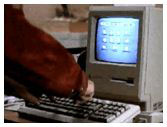If TV Characters Used Real
Computers got me to thinking about one of my own favorite TV
(and movie) genres, science fiction, which of course has a great
deal to do with computers and the future. Of course I gravitated
toward television's greatest sci-fi saga, parent of spinoff,
imitations, and series that would never have seen the light of day
if it had not made such a great impression on the imagination of
the public. I refer, of course, to Star Trek, both TV series and
films.
Having considered this show, its influence, and the veritable
universe it has created around itself, I have come to a conclusion
which should gladden the hearts of Mac users and Mac partisans
everywhere. It is verifiable and logical - even by Vulcan
standards.
The technological and personal future of humanity undeniably
belongs to the Macintosh.
Consider: in the best film of the Star Trek motion picture
series, Star Trek IV: The Voyage Home, the crew of the Enterprise
has traveled back in time to the late 1980s to bring humpback
whales into the future so they can talk to a space probe that can
only understand their language patterns. The probe is wreaking
havoc with Earth's weather.
They must find a way to fabricate a light, strong material to
line the area in the starship where the whales will be kept, and
 so Scotty and Dr. McCoy
arrive at a fabrication facility in San Francisco, masquerading as
a genius engineer and his assistant from Europe, there to
collaborate on production of a new alloy. The people at the
facility are skeptical, but they allow Scotty to use their computer
to draw up fabrication instructions. After first mistaking the
mouse for a microphone, Scotty gets immediately to work and
produces instructions and blueprints within a minute or so.
so Scotty and Dr. McCoy
arrive at a fabrication facility in San Francisco, masquerading as
a genius engineer and his assistant from Europe, there to
collaborate on production of a new alloy. The people at the
facility are skeptical, but they allow Scotty to use their computer
to draw up fabrication instructions. After first mistaking the
mouse for a microphone, Scotty gets immediately to work and
produces instructions and blueprints within a minute or so.
Guess what computer he was using? One of the early Macintosh
all-in-ones (it's in the closing credits). It was fast,
flexible, and efficient. It didn't crash when Scotty entered
information so quickly that the twentieth-century people watching
were astonished. In short, the movie Mac behaved just like Macs do
in real life.
In the Star Trek universe, a Macintosh helped save the Earth
from destruction. But consider also how quickly Chief Engineer
Montgomery Scott was able to adapt to the (for him, and perhaps now
for us) ancient computer's operating system and do his work!
I submit that this is because the operating system Scotty was
accustomed to using in the future could only be a direct descendant
of the OS he was called upon to use in the 20th century on that
little compact Mac: easy, friendly, intuitive, and powerful.
Windows of the 23rd century? Hardly.
2001: A Space Odyssey showed the more cautionary attitude
necessary for using Windows on outer space missions, presenting the
psychotic break experienced by HAL (read: IBM) the computer. Most
Windows users have experienced the same or similar: the PC freezes,
stops what it's supposed to be doing, and won't really tell you
why. The cryptic Windows error message of today is the "Dave, I
don't see anything wrong with what I've done" of tomorrow.
No, the ship's computer would have to be responsive, powerful,
flexible, up to any challenge, and possess a degree of
sophisticated operation that would all but guarantee no possibly
lethal temper tantrums.
It could only be a 23rd century version of the Mac OS (perhaps
Mac OS XXIII)?
This tells us beyond any reasonable doubt that the future - the
best future, as exemplified by the Star Trek universe - belongs to
the Macintosh. Look at the Mac you use, whether it be an old
compact or Quadra, a Power Mac 6100, 9600, an iMac, or the
blazingly-fastest G4 presently being made, and realize that the
genius responsible for this computer and operating system has to be
the one to take humankind where no one has gone before - and back
again. This will allow all of us, and the future itself, to live
long and prosper.
Straightforwardly and supremely logical.
Share your perspective on the Mac by emailing with "My Turn" as your subject.

 so Scotty and Dr. McCoy
arrive at a fabrication facility in San Francisco, masquerading as
a genius engineer and his assistant from Europe, there to
collaborate on production of a new alloy. The people at the
facility are skeptical, but they allow Scotty to use their computer
to draw up fabrication instructions. After first mistaking the
mouse for a microphone, Scotty gets immediately to work and
produces instructions and blueprints within a minute or so.
so Scotty and Dr. McCoy
arrive at a fabrication facility in San Francisco, masquerading as
a genius engineer and his assistant from Europe, there to
collaborate on production of a new alloy. The people at the
facility are skeptical, but they allow Scotty to use their computer
to draw up fabrication instructions. After first mistaking the
mouse for a microphone, Scotty gets immediately to work and
produces instructions and blueprints within a minute or so.
